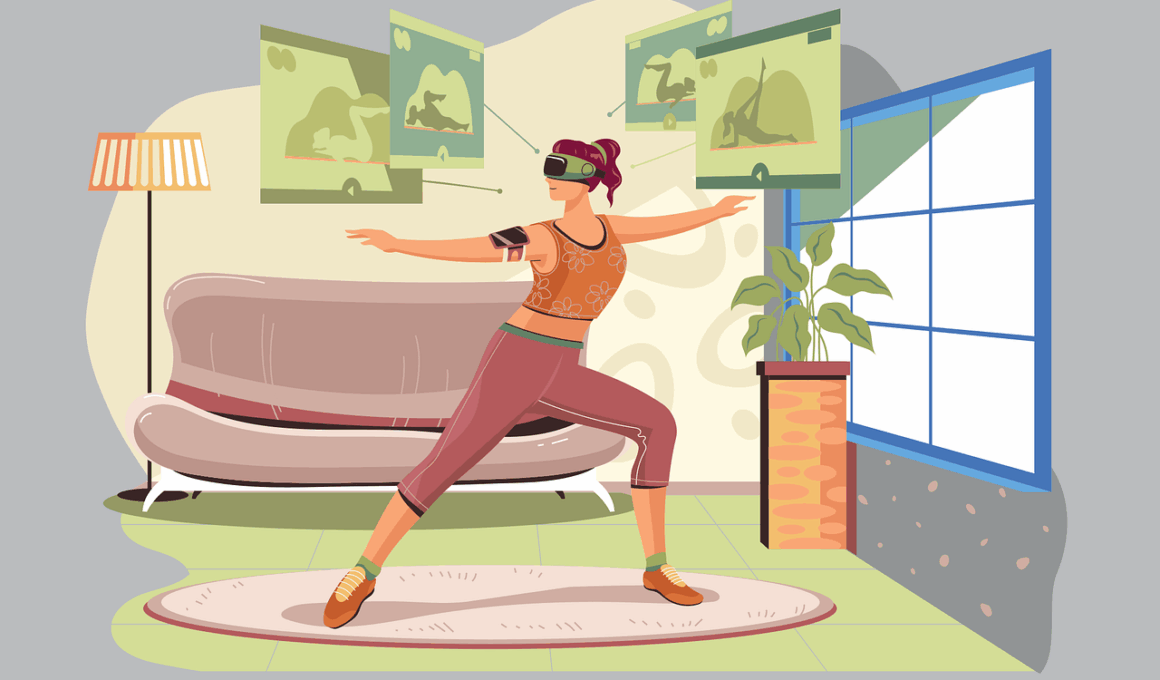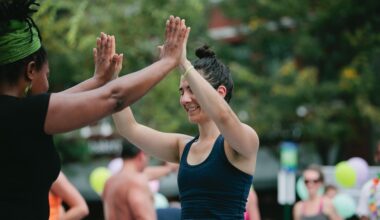How Virtual Reality Motivates Users to Achieve Strenuous Fitness Goals
The emergence of virtual reality (VR) technology has transformed how fitness enthusiasts approach their workouts. One of the most significant advantages of VR fitness apps is their ability to create immersive environments that can captivate users’ attention. By simulating exotic locations or exciting gameplay, users are more likely to engage in physical activities that they might otherwise find tedious. This enhanced engagement can result in longer workout durations and improved adherence to fitness regimes. Furthermore, VR apps often incorporate gamification elements, creating a sense of competition and achievement that can boost motivation. Users can track their goals and see measurable progress, which fosters a sense of accomplishment. For instance, when users complete challenges or reach new levels, they receive tangible feedback through rewards. This kind of immediate gratification is crucial in maintaining motivation. The combination of immersive experiences and gamification can encourage users to push their limits, provided these elements are designed effectively and provide a satisfying user experience. Overall, the VR fitness landscape continues to evolve, offering innovative solutions to help users stay motivated as they pursue their fitness objectives.
The Science Behind VR Fitness Motivation
Understanding how virtual reality influences motivation requires examining psychological principles. One critical aspect is the concept of presence, which allows users to feel as though they are genuinely present in another environment. Research indicates that high levels of presence can significantly enhance motivation for fitness activities. When users feel transported to a virtual world, their enjoyment of the activity increases, making them less aware of physical exertion. This emotional response can lead individuals to engage in workouts that they would typically avoid, thus achieving strenuous fitness goals more readily. Additionally, VR environments often create a social component, connecting users with others in shared experiences. This can foster accountability and community, making it easier for users to stick to their fitness plans. Furthermore, by overcoming physical and mental barriers to exercise, VR can empower users to unleash their potential. Virtual classes allow them to work alongside others without judgment, enhancing their confidence levels. Overall, these psychological mechanisms work synergistically to drive motivation and commitment, allowing individuals to explore the remarkable capabilities of their bodies through guided experiences.
The design and functionality of virtual reality fitness apps play a crucial role in enhancing user experience. Interfaces that prioritize user-friendliness can significantly impact motivation levels. For example, intuitive controls and customizable settings allow users to feel more in control of their fitness journey. When users can tailor their workouts according to personal preferences, they are more likely to stay engaged and committed. Additionally, providing clear instructions and feedback throughout workouts can help users understand their progress, thereby reinforcing goal achievement. High-quality graphics and sound effects contribute to the immersive experience and can make fitness sessions feel more authentic. By creating captivating environments that mimic real-world activities, users are encouraged to push their limits without the physical constraints often experienced in conventional gyms. Furthermore, social features enabling workout sharing and competitions among users can seamlessly integrate into the app. This social interaction fosters a motivating atmosphere that can lead to continuous improvement. Regular updates and the introduction of new challenges are also vital to retaining user interest. In conclusion, efficient design aligns with user goals and interests, crucially sustaining motivation through their fitness journeys.
The Benefits of Social Interaction in VR Fitness
One of the most compelling aspects of virtual reality fitness apps is their ability to create social interactions among users. By allowing participants to join virtual workout classes or socialize within app communities, users can enjoy camaraderie that motivates them to maintain their fitness routines. Sharing goals, challenges, and triumphs with peers can encourage accountability, making individuals less likely to skip workouts. Furthermore, these social dynamics can help create a sense of belonging and support. Users can bond over shared experiences, celebrate each other’s achievements, and offer encouragement, creating an uplifting atmosphere that fosters perseverance. The ability to join real-time fitness classes with others can also mimic the benefits of in-person group workouts, directing users toward their fitness objectives. Additionally, receiving direct feedback from other participants helps propel motivation to new heights. Through this interconnectedness, users may find themselves embracing healthier lifestyles and staying committed to their fitness journeys, not only through competition but also through collaboration. The collective energy that emerges from these connections can inspire users to venture beyond their limits, leading to meaningful fitness transformations.
Another significant factor influencing motivation in virtual reality fitness is the integration of personalized fitness coaching. Many VR fitness apps offer virtual trainers that provide tailored exercises, ensuring workouts align with individual goals and fitness levels. This personalized guidance can help users feel supported throughout their journeys, making it easier to address specific challenges they may face when attempting to reach strenuous fitness goals. Coaches can adapt workouts based on user performance, allowing individuals to gradually increase intensity as their abilities improve. Furthermore, the interactive nature of virtual trainers can enhance the user experience by providing real-time feedback and encouragement. Users tend to respond better to personalized coaching since they feel like they have someone rooting for them, balancing challenge with achievable results. Regular interaction with a guide also helps users establish a routine, solidifying their habits over time. Virtual coaching may include encouragement during tough workouts, which is essential for mental resilience during demanding sessions. Overall, by integrating personalized coaching into VR fitness experiences, users receive the motivation needed to push their limits and achieve long-lasting fitness success.
Emerging Trends in VR Fitness Apps
The landscape of virtual reality fitness apps is continuously evolving, with emerging trends that aim to enhance user experience and motivation. One such trend is the incorporation of advanced motion tracking. This technology allows users to engage in more dynamic and realistic workouts, as their movements are precisely mirrored in virtual environments. Enhanced tracking capabilities empower users to explore various workout modalities, such as dancing or martial arts, immersing themselves in fun while burning calories. Another notable trend is the focus on mindfulness and mental well-being, integrating virtual meditation and relaxation experiences into fitness apps. This convergence of physical activity and mental health promotes holistic wellness, motivating users to maintain a balance between fitness and mental well-being. Additionally, the inclusion of fitness challenges and community events can create excitement and a sense of urgency among users, pushing them to break out of their comfort zones. Adapting to seasonal themes or popular trends can also keep content fresh and engaging. Overall, these emerging trends point toward a future where virtual reality fitness apps cater to diverse user needs and preferences, further enhancing motivation and engagement.
The long-term benefits of using virtual reality fitness apps extend beyond motivation and adherence to a regular fitness routine. These apps foster a deeper understanding of personal abilities, encouraging users to set realistic yet progressive fitness goals over time. As users continually engage with these virtual experiences, they develop not only improved physical fitness but also enhanced confidence and self-esteem. This transformation can significantly impact users’ lives outside the typical gym environment, permeating personal, social, and professional facets. Furthermore, ongoing participation in VR fitness often leads to fostering a genuine enthusiasm for health and wellness. Participants may explore other avenues, such as joining local fitness communities or adopting healthier nutrition habits. Enhanced community integration, whether virtually or in person, can lead to lasting friendships and support connections. Additionally, the skills and resilience developed while using these apps can help users face everyday challenges with a stronger mindset. In summary, virtual reality fitness apps significantly impact users’ physical health and overall quality of life, leading to lasting transformations aligned with their fitness aspirations and creating an engaged, health-focused lifestyle.
As we look to the future of fitness technology, virtual reality stands at the forefront of innovation. Combining fitness with immersive experiences, VR apps infuse excitement into workouts, enticing users to engage. New developments in artificial intelligence may further enhance personal coaching technologies, ensuring that feedback becomes progressively more precise and impactful. Additionally, advancements in graphics and user interfacing can create even better immersive environments, increasing users’ emotional connections. As VR headsets become more accessible and affordable, a growing audience can explore the benefits of virtual workouts. Research continues to support the efficacy of VR in promoting exercise adherence among various demographics. This growing body of evidence underscores the importance of investing in technology that excites and motivates users to achieve their fitness goals. The potential for data analytics to track users’ progress could also be a game-changer, allowing for tailored experiences built around individual capabilities and preferences. Overall, the bright future of virtual reality fitness reflects broader trends in technology and personal wellness. As fitness enthusiasts seek ways to stay engaged and motivated, VR will remain a vital tool in their journey toward a healthier lifestyle.


